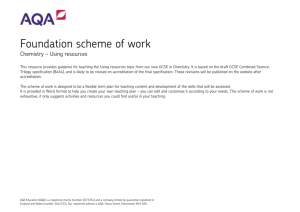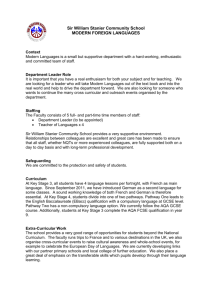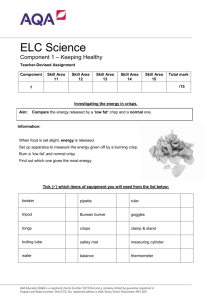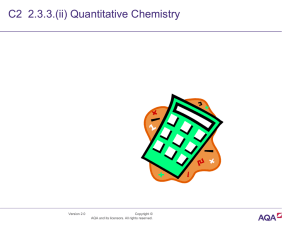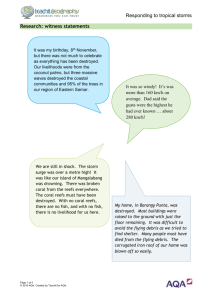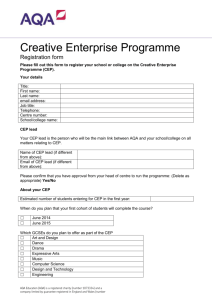Physics – Particle model of matter
advertisement
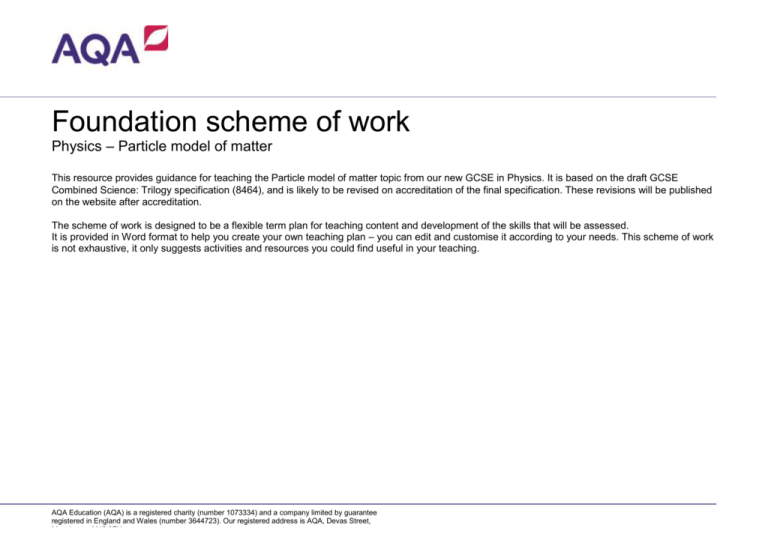
Foundation scheme of work Physics – Particle model of matter This resource provides guidance for teaching the Particle model of matter topic from our new GCSE in Physics. It is based on the draft GCSE Combined Science: Trilogy specification (8464), and is likely to be revised on accreditation of the final specification. These revisions will be published on the website after accreditation. The scheme of work is designed to be a flexible term plan for teaching content and development of the skills that will be assessed. It is provided in Word format to help you create your own teaching plan – you can edit and customise it according to your needs. This scheme of work is not exhaustive, it only suggests activities and resources you could find useful in your teaching. AQA Education (AQA) is a registered charity (number 1073334) and a company limited by guarantee registered in England and Wales (number 3644723). Our registered address is AQA, Devas Street, Manchester M15 6EX. 6.6 Particle model of matter 6.6.1 Changes of state and the particle model Spec ref. 6.6.1.1 Summary of the specification content Density of materials Learning outcomes What most candidates should be able to do The density of a material is defined by the equation: 𝑚𝑎𝑠𝑠 𝑑𝑒𝑛𝑠𝑖𝑡𝑦 = 𝑣𝑜𝑙𝑢𝑚𝑒 𝑚 [𝑝 = ] 𝑉 density, ρ, in kilograms per metre cubed, kg/m 3 mass, m, in kilograms, kg volume, V, in metre cubed, m3 Suggeste d timing (hours) 2 Opportunities to develop scientific communication skills Define density. Describe the method used to find the density of regular shapes. Convert non-standard units into standard units for calculations. Apply the equation for density. Students should perform practice calculations to help them remember the equation. Calculate the density, mass or volume of an irregularly shaped object. AQA Education (AQA) is a registered charity (number 1073334) and a company limited by guarantee registered in England and Wales (number 3644723). Our registered address is AQA, Devas Street, Manchester M15 6EX. Opportunities to develop and apply practical and enquiry skills Demonstrate different density fluid by first measuring the mass of three equal volumes of corn syrup, water and vegetable oil and then pouring into a beaker (heaviest first). Describing density Pupils investigate density of two equally sized regular shapes: eg polystyrene block and metal block. Self/peer assessment Opportunities and resources Reference to past questions that indicate success ExamPro KS3 Physics QPM94P120 Students can evaluate different methods of measuring volume of irregularly shaped object (ie using rulers vs immersion in water). Calculate volume of each object (l x h x w) and measure mass of each. Convert cm and g into SI units. 2 of 13 Spec ref. Summary of the specification content Learning outcomes What most candidates should be able to do Suggeste d timing (hours) Opportunities to develop scientific communication skills Opportunities to develop and apply practical and enquiry skills Self/peer assessment Opportunities and resources Reference to past questions that indicate success Students calculate density for each block. Test by putting into a container of water and measuring change in water levels. Which fruit and vegetables are the heavyweights? Investigate using a selection of different fruits. Measure mass. Use measuring cylinders/ graduated beakers to measure volume. Calculate density of each. Compare their density to that of water. Link to the story about Archimedes and the king’s crown. Required practical 16: investigate, using appropriate apparatus, the densities of AQA Education (AQA) is a registered charity (number 1073334) and a company limited by guarantee registered in England and Wales (number 3644723). Our registered address is AQA, Devas Street, Manchester M15 6EX. 3 of 13 Spec ref. Summary of the specification content Learning outcomes What most candidates should be able to do Suggeste d timing (hours) Opportunities to develop scientific communication skills Opportunities to develop and apply practical and enquiry skills Self/peer assessment Opportunities and resources Reference to past questions that indicate success 6.6.1.1 The particle model and density of materials The particle model can be used to explain the different states of matter. The differences in density between the different states of matter to be explained in terms of the arrangements of the particles (atoms or molecules). 1 Recap KS3 by drawing diagrams to show the particle arrangements in solid, liquid and gases and describing the motion of particles in solids, liquids and gases. Compare the different states of matter and how numbers of particles in a volume might influence mass and density. Use the diagrams to explain the differences in densities between solids, liquids and gases. Examine the reasons why ice has a lower density than water. AQA Education (AQA) is a registered charity (number 1073334) and a company limited by guarantee registered in England and Wales (number 3644723). Our registered address is AQA, Devas Street, Manchester M15 6EX. regular and irregular solid objects and liquids, making and recording appropriate measurements. Use a tray filled with pingpong balls or marbles to demonstrate particle motions in the three states. Make models of solids, liquids and gases using plasticine. Compare three equal masses of plasticine modelled into each state (and how volume varies). Then make the three states in a set volume (draw a 5 x 5 cm onto A4 paper) and compare the resulting masses. ExamPro GCSE Physics QPKP.5F.10 KS3 Chemistry Q98.B1.10 Peer assessment can be used to mark particle models. Label the models to link the state of matter with the density. 4 of 13 Spec ref. 6.6.1.2 Summary of the specification content Changing of state Learning outcomes What most candidates should be able to do When substances change state (melt, freeze, boil, evaporate, condense or sublimate), mass is conserved. Suggeste d timing (hours) 0.5 Opportunities to develop scientific communication skills Describe the changes of state in terms of solids, liquids and gases. Describe how, when a substance changes state, the mass of the substance is unchanged as there is still the same number of atoms in the substance and it is just their arrangement that has altered. AQA Education (AQA) is a registered charity (number 1073334) and a company limited by guarantee registered in England and Wales (number 3644723). Our registered address is AQA, Devas Street, Manchester M15 6EX. Opportunities to develop and apply practical and enquiry skills Measure the mass of an ice cube and then re-measure when it has melted. Establish that mass remains unchanged, only particle arrangement changes. Self/peer assessment Opportunities and resources Reference to past questions that indicate success ExamPro GCSE Physics QK13W5F11 QK12W5F08 KS3 Chemistry Q08.A2.04 Q00.A1.06 Q12W1f07 Use mini white boards to check pupil understanding of state changes. 5 of 13 Spec ref. 6.6.1.2 Summary of the specification content Chemical and physical changes Learning outcomes What most candidates should be able to do Changes of state are physical changes; the change does not produce a new substance. If the change is reversed, the substance recovers its original properties. Suggeste d timing (hours) 0.5 Opportunities to develop scientific communication skills Describe the difference between a chemical and a physical change and provide examples for both types. Describe how, if a physical change is reversed, the substance will recover its original properties. AQA Education (AQA) is a registered charity (number 1073334) and a company limited by guarantee registered in England and Wales (number 3644723). Our registered address is AQA, Devas Street, Manchester M15 6EX. Opportunities to develop and apply practical and enquiry skills What is the difference between a chemical and a physical change? Self/peer assessment Opportunities and resources Reference to past questions that indicate success ExamPro KS3 Chemistry Q09.A1.01 Use chocolate buttons to demonstrate the reversible properties of melting and cooling. 6 of 13 6.6.2 Internal energy and energy transfers Spec ref. 6.6.2.1 Summary of the specification content Internal energy of materials Learning outcomes What most candidates should be able to do Energy is stored inside a system by the particles (atoms and molecules) that make up the system. This is called internal energy. Internal energy is the total kinetic energy and potential energy of all the particles (atoms and molecules) that make up a system. Suggeste d timing (hours) 1 Opportunities to develop scientific communication skills Define internal energy. Describe temperature being a measure of the average kinetic energy of the particles in a substance. AQA Education (AQA) is a registered charity (number 1073334) and a company limited by guarantee registered in England and Wales (number 3644723). Our registered address is AQA, Devas Street, Manchester M15 6EX. Opportunities to develop and apply practical and enquiry skills What is the difference between heat and temperature? Model the behaviour of atoms within a solid as it is heated past its melting point using a tray of ping-pong balls. Demonstrate the changing diameter of a balloon as it is plunged into ice cold vs hot water. Link to the amount of kinetic energy in the air particles. Self/peer assessment Opportunities and resources Reference to past questions that indicate success ExamPro GCSE Science A QP13W.1F.03 Ask students to compare bonfire sparklers with a lukewarm bath – the sparkler has relatively low total heat energy as there are few molecules. 7 of 13 Spec ref. 6.6.2.1 6.6.2.2 Summary of the specification content Heat and temperature Specific heat capacity Learning outcomes What most candidates should be able to do Heating changes the energy stored within the system by increasing the energy of the particles that make up the system. This either raises the temperature of the system or produces a change of state. 1 If the temperature of the system increases: 1 The increase in temperature depends on the mass of the substance heated, what the substance is and the energy input to the system. The following equation applies: 6.6.2.2 Suggeste d timing (hours) 𝑐ℎ𝑎𝑛𝑔𝑒 𝑖𝑛 𝑡ℎ𝑒𝑟𝑚𝑎𝑙 𝑒𝑛𝑒𝑟𝑔𝑦 = 𝑚𝑎𝑠𝑠 𝑥 𝑠𝑝𝑒𝑐𝑖𝑓𝑖𝑐 ℎ𝑒𝑎𝑡 𝑐𝑎𝑝𝑎𝑐𝑖𝑡𝑦 𝑥 𝑡𝑒𝑚𝑝𝑒𝑟𝑎𝑡𝑢𝑟𝑒 𝑐ℎ𝑎𝑛𝑔𝑒 Opportunities to develop scientific communication skills Describe and explain how increasing the temperature of a substance affects the internal energy of a substance. Opportunities to develop and apply practical and enquiry skills What effect does changing the temperature of an object have on the atoms that make up the object? Demonstrate expansion using metal ball and hoop/ bimetallic strips. Describe heat capacity as how much thermal energy a material stores up and temperature as how much thermal energy a material gives off. Describe why different things heat up differently when they have the same amount of energy in terms of the differing specific heat capacity. Define specific heat capacity. AQA Education (AQA) is a registered charity (number 1073334) and a company limited by guarantee registered in England and Wales (number 3644723). Our registered address is AQA, Devas Street, Manchester M15 6EX. Why is the pie filling always hotter than the crust? Why is the pavement always hotter than the grass? Does water or sand heat up faster at the beach? Investigate the rate of heating sand vs water (to model a beach). Use equal depths of sand and water in beakers, covering thermometer bulbs. Self/peer assessment Opportunities and resources Reference to past questions that indicate success ExamPro KS3 Chemistry Q97.B2.11 Q00.A1.14 Ask students to draw a flow diagram to illustrate how the movement of particles change as a thermometer warms up. ExamPro GCSE Science A QP13S.1F.06 QP14S.1F.05 GCSE Physics QK14S5F11 Give students the energy of the lamp (energy (J) = power (this will be the bulb wattage in Watts) x time (in 8 of 13 Spec ref. Summary of the specification content Learning outcomes What most candidates should be able to do [∆𝐸 = 𝑚 𝑐 ∆𝜃 ] change in thermal energy, ∆E, in joules, J mass, m, in kilograms, kg specific heat capacity, c, in joules per kilogram per degree Celsius, J/kg oC temperature change, ∆θ, in degrees Celsius, oC The specific heat capacity of a substance is the amount of energy required to raise the temperature of one kilogram of the substance by one degree Celsius. Suggeste d timing (hours) Opportunities to develop scientific communication skills Describe the factors that affect how quickly a substance heats up, eg mass, temperature difference. The equation will be provided on the equations sheet. Students should be able to convert to SI units and use standard form in their answers. Use the temperature changes to calculate the energy changes of each material (when SHC of sand 830 J/kg oC and water 4,200 J/kg oC). Opportunities to develop and apply practical and enquiry skills Position filament lamps above the bulbs of the thermometers and record temperature changes every minute for 10 minutes. Turn lamps off and record temperature drop for the next 10 minutes. Plot the data for both water and sand. Self/peer assessment Opportunities and resources Reference to past questions that indicate success seconds). Students assess accuracy of their data by comparing their SHC value with the accepted value (when SHC of sand 830 J/kg oC and water 4,200 J/kg oC). It takes more energy to heat up water by each oC than same mass of sand. Describe why water is used in hot water bottles whereas metals are used to make heatsinks. AQA Education (AQA) is a registered charity (number 1073334) and a company limited by guarantee registered in England and Wales (number 3644723). Our registered address is AQA, Devas Street, Manchester M15 6EX. 9 of 13 Spec ref. 6.6.2.3 Summary of the specification content Specific latent heat Learning outcomes What most candidates should be able to do If a change of state happens: The energy needed for a substance to change state is called latent heat. When a change of state occurs, the energy supplied changes the energy stored (internal energy) but not the temperature. The specific latent heat of a substance is the amount of energy required to change the state of one kilogram of the substance with no change in temperature. Suggeste d timing (hours) 1 Opportunities to develop scientific communication skills Define specific latent heat. Explain why a block of ice at 0 °C that is being heated does not increase in temperature initially. Calculate the energy required for the change of state (specific latent heat for stearic acid 2,359 J/kg). Students will be expected to convert to SI units and use standard form where required. 𝑒𝑛𝑒𝑟𝑔𝑦 𝑓𝑜𝑟 𝑎 𝑐ℎ𝑎𝑛𝑔𝑒 𝑜𝑓 𝑠𝑡𝑎𝑡𝑒 = 𝑚𝑎𝑠𝑠 𝑥 𝑠𝑝𝑒𝑐𝑖𝑓𝑖𝑐 𝑙𝑎𝑡𝑒𝑛𝑡 ℎ𝑒𝑎𝑡 Opportunities to develop and apply practical and enquiry skills Investigate the specific latent heat of fusion of water. Self/peer assessment Opportunities and resources Reference to past questions that indicate success ExamPro KS3 Chemistry Q96.A1.14 Complete a cooling curve of a measured volume of liquid stearic acid. Start in a hot water bath at 80oC. Take temperature of both stearic acid and water bath and plot both on a graph of temperature vs time. At around 68oC the two lines will diverge and the stearic acid will remain hotter as it turns from liquid to solid. Once stearic acid is solid, it will continue releasing heat. [𝐸 = 𝑚𝐿] energy, E, in joules , J mass, m, in kilograms, kg specific latent heat, L, in joules per kilogram, J/kg AQA Education (AQA) is a registered charity (number 1073334) and a company limited by guarantee registered in England and Wales (number 3644723). Our registered address is AQA, Devas Street, Manchester M15 6EX. 10 of 13 Spec ref. Summary of the specification content Learning outcomes What most candidates should be able to do Suggeste d timing (hours) Opportunities to develop scientific communication skills Opportunities to develop and apply practical and enquiry skills Self/peer assessment Opportunities and resources Reference to past questions that indicate success 6.6.2.3 Specific latent heat The specific latent heat of fusion of a solid substance is the heat required to change one kilogram of it from solid to liquid without any temperature change. The specific latent heat of vaporisation of a liquid substance is the heat required to change one kilogram of it from liquid to vapour without any temperature change. 1 Define specific latent heat of fusion and vaporisation. Describe why more energy is needed to change water into steam compared to ice into water (because there is more separation of the particles). AQA Education (AQA) is a registered charity (number 1073334) and a company limited by guarantee registered in England and Wales (number 3644723). Our registered address is AQA, Devas Street, Manchester M15 6EX. Why does steam cause worse burns than boiling water? Use plasticine or molymod models to demonstrate bond breaking in gases, compared to fewer breakages in liquids. Establish that more energy is needed as more distance is involved. 11 of 13 6.6.3 Particle model and pressure Spec ref. 6.6.3.1 6.6.3.1 Summary of the specification content Particle motion in gases How gases exert forces on the walls of their containers Learning outcomes What most candidates should be able to do Suggeste d timing (hours) The molecules of a gas are in constant random motion. The temperature of the gas is related to the average kinetic energy of the molecules. The higher the temperature, the greater the average kinetic energy and so the faster the average speed of the molecules. 1 When the molecules collide with the wall of their container they exert a force on the wall. The total force exerted by all of the molecules inside the container on a unit area of the walls is the gas pressure. 1 Opportunities to develop scientific communication skills Describe the motion of molecules within a gas. Describe and explain how the motion of molecules in a gas changes as the gas is heated. Describe how molecules in a gas are moving faster (because with a higher temperature they have more energy). Describe that gases exert a force on a container. Describe what is meant by gas pressure in terms of the forces exerted by the gas molecules on the surface of a container. AQA Education (AQA) is a registered charity (number 1073334) and a company limited by guarantee registered in England and Wales (number 3644723). Our registered address is AQA, Devas Street, Manchester M15 6EX. Opportunities to develop and apply practical and enquiry skills Revisit the demonstration of gases using a tray of marbles. Model increasing motion with increasing temperature. Demonstrate air pressure crushing a soda can by inverting a can with a small amount of heated water into a container of cold water. Self/peer assessment Opportunities and resources Reference to past questions that indicate success ExamPro KS3 Chemistry QY13W5F11 ExamPro KS3 Chemistry Q05.A2.10 Q96.B2.11 Demonstrate what happens to a marshmallow when it is put into a vacuum chamber, and equally what happens when the air is returned to the chamber and pressure is increased. 12 of 13 Spec ref. Summary of the specification content Learning outcomes What most candidates should be able to do Suggeste d timing (hours) Opportunities to develop scientific communication skills Opportunities to develop and apply practical and enquiry skills Self/peer assessment Opportunities and resources Reference to past questions that indicate success 6.6.3.1 How changing the temperature of a gas affects the pressure exerted Changing the temperature of a gas, held at constant volume, changes the pressure exerted by the gas. 1 Describe how increasing the temperature of gas increases the gas pressure inside the container. Draw and label a variety of diagrams showing different gas pressures. Discuss methods to ensure consistent measurements around the balloon are taken (ie by drawn marks where measurements are taken). AQA Education (AQA) is a registered charity (number 1073334) and a company limited by guarantee registered in England and Wales (number 3644723). Our registered address is AQA, Devas Street, Manchester M15 6EX. Inflate a balloon. Draw diagrams to illustrate how the numbers of particles are changing as the balloon is inflated. Discuss the increase in particles colliding with the balloon’s surface and the increase in pressure. Use a tray of marbles or pingpong balls to illustrate the differences in gaps between liquid/ gas particles and what happens as they are both heated. Why do aerosol deodorants say keep away from fire? ExamPro KS3 Chemistry Q02.A2.14 Q99.B1.11 Measure the diameter of a partially inflated balloon. Plunge it into ice cold water for several minutes and premeasure. Repeat in a water bath at 80oC. Compare the change in the diameter. 13 of 13



